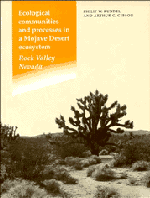Book contents
- Frontmatter
- Contents
- Preface
- Historical prologue on Rock Valley studies
- 1 Introduction to the Mojave Desert
- 2 Physical geography of Rock Valley
- 3 Adaptations of Mojave Desert plants
- 4 Desert perennials of southern Nevada
- 5 Mojave Desert annuals
- 6 Adaptations of Mojave Desert animals
- 7 Mammals
- 8 Reptiles
- 9 Birds
- 10 Arthropods
- 11 Soil organisms and seed reserves
- 12 Nitrogen cycling
- 13 Human impacts on Mojave Desert ecosystems
- References
- Species index
- Main index
9 - Birds
Published online by Cambridge University Press: 19 October 2009
- Frontmatter
- Contents
- Preface
- Historical prologue on Rock Valley studies
- 1 Introduction to the Mojave Desert
- 2 Physical geography of Rock Valley
- 3 Adaptations of Mojave Desert plants
- 4 Desert perennials of southern Nevada
- 5 Mojave Desert annuals
- 6 Adaptations of Mojave Desert animals
- 7 Mammals
- 8 Reptiles
- 9 Birds
- 10 Arthropods
- 11 Soil organisms and seed reserves
- 12 Nitrogen cycling
- 13 Human impacts on Mojave Desert ecosystems
- References
- Species index
- Main index
Summary
Desert scrub habitats, which have low annual precipitation, simple vegetational structure, and low primary production, support few resident bird populations unless permanent water is available (Serventy 1971). For each continent there is a very short list of species that are truly characteristic of thriving under desert conditions. For example, despite biogeographic dominance of desert and semi-desert environments in Australia, which comprise the central 70% of that continent, Keast (1959) identified only 17 bird species as characteristic of the region, just 3% of total breeding avifauna. Likewise, in North America only 31 species of birds are listed as desert inhabitants (MacMahon 1979). Nevertheless, in spring and fall transient populations of many bird species migrate through dryland habitats on the Desert scrub habitats, which have low annual precipitation, simple vegetational structure, and low primary production, Nevada Test Site, and some bird species are seasonal or year-round residents, having some adaptations for desert life (Dawson & Bartholomew 1968; Dawson 1984).
BIRDS OF THE NEVADA TEST SITE
The avifauna of the Nevada Test Site consists of 220 species (Table 9.1; data as of 1991) of which at least 160 were classified as transients (Allred et al. 1963; Hayward et al. 1963; O' Farrell & Emery 1976; Castetter & Hill 1979; BECAMP 1991b Many transients were sighted during biannual mass bird migrations as part of the western North America flyway, and birds rest and feed at NTS during cool months, especially when precipitation occurs (Chapter 2) and creates temporary standing water. On-site breeding has only been confirmed at NTS for 31 species, largely those living at the higher, cooler, less ari habitats.
- Type
- Chapter
- Information
- Publisher: Cambridge University PressPrint publication year: 1996
- 1
- Cited by



